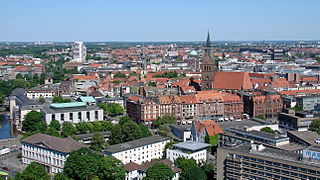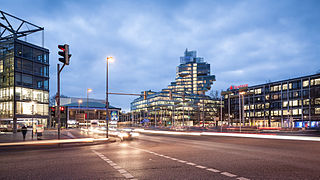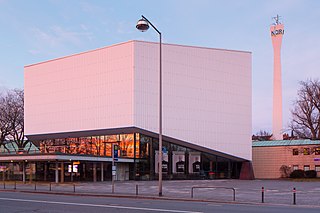
Hanover is the capital and largest city of the German state of Lower Saxony. Its 535,932 (2021) inhabitants make it the 13th-largest city in Germany as well as the fourth-largest city in Northern Germany after Berlin, Hamburg and Bremen. Hanover's urban area comprises the towns of Garbsen, Langenhagen and Laatzen and has a population of about 791,000 (2018). The Hanover Region has approximately 1.16 million inhabitants (2019).

Sprengel Museum is a museum of modern art in Hanover, Lower Saxony, holding one of the most significant collections of modern art in Germany. It is located in a building situated adjacent to the Masch Lake approximately 150 metres (490 ft) south of the state museum. The museum opened in 1979, and the building, designed by Peter and Ursula Trint and Dieter Quast, was extended in 1992.

The Masch Lake is an artificial river situated south of the city centre of Hanover, the capital of Lower Saxony, Germany. Spanning an area of 78 hectares, it is the largest body of water within Hanover and a popular recreation area as well as venue for numerous water sports.

The Garden Cemetery is a cemetery in Hanover, Germany. It was created in 1741 and is located by the Garden Church built in 1749. The cemetery and the church are both named after the garden parish outside the former parish city walls in front of Aegidien Gate. The cemetery, which contains a number of classicising grave markers from the first half of the nineteenth century, was closed in 1864 with the establishment of the Stadtfriedhof Engesohde. Today it forms a park in the middle of inner city Hanover. The graves of Charlotte Buff, the astronomer Caroline Herschel and the painter Johann Heinrich Ramberg are located here. The Gartenfriedhof lies on Marienstraße between Warmbüchenstraße and Arnswaldtstraße.

Aegidien Gate Square is a busy square known colloquially as Aegi in Hanover, Germany. Located above a subway station of the same name, the square was named for the Aegidien Gate, one of the city gates of medieval Hanover. While the gate was removed in 1780, the square is still named after it.

Major-general Friedrich Otto Gebhard von Kielmansegg was a German soldier and officer in the service of the Kingdom of Hanover who fought during the Waterloo Campaign.
The following is a timeline of the history of the city of Hanover, Germany.

Aegidien Church, after Saint Giles to whom the church was dedicated, is a war memorial in Hanover, the capital of Lower Saxony, Germany. The church dates from 1347, when it replaced an older Romanesque church dating to 1163. This in turn replaced an even earlier chapel. Aegidien Church was destroyed during the night beginning 8 October 1943 by aerial bombings of Hanover during World War II. In 1952, Aegidien Church became a war memorial dedicated to victims of war and of violence.

The aerial bombings of Hanover are a series of eighty-eight air raids by Royal Air Force (RAF) Bomber Command and the United States Army Air Forces (USAAF) on the German city of Hanover during World War II. Collectively these air raids killed 6,782 persons, predominantly civilian residents. Around 1,000 aerial mines, 34,000 high explosive bombs, 900,000 incendiary bombs and 50,000 fire bombs were dropped. The most destructive and deadly air raid on Hanover was conducted by the RAF on the night beginning 8 October 1943, killing 1,245 persons, and is an example of carpet bombing of suburban and residential civilian targets laid out in the Area Bombing Directive of 14 February 1942.

Landesfunkhaus Niedersachsen is a group of buildings of the public broadcaster Norddeutscher Rundfunk in Hanover, the state capital of Lower Saxony.

Johann Georg Christian Kestner was a German lawyer and archivist. He is also notable as the model for Lotte's husband Albert in The Sorrows of Young Werther by Goethe, with Kestner's fiancée Charlotte Buff used as the model for Lotte herself.
Hugo Thielen is a German freelance author and editor, who is focused on the history of Hanover, the capital of Lower Saxony, in a lexicon of the city, another one especially of its art and culture, and a third of biographies. He co-authored a book about Jewish personalities in Hanover's history.

Klaus Mlynek is a German historian and scientific archivist. The long-term director of the Stadtarchiv Hannover is one of the editors and authors of the Hannover City Lexicon , an encyclopedia of Hanover.
Waldemar R. Röhrbein was a German historian. He worked as a museum director in Lower Saxony, his last post being from 1976 to 1997 at the Historisches Museum Hannover, and was president of the Homeland Federation of Lower Sachsony. He contributed to encyclopedias about Hanover's history and culture.

Hanover Historical Museum is an historical museum situated in Hanover, the capital of Lower Saxony, Germany. The museum was founded in 1903 as the Homeland Museum of the City of Hanover. Its collections are related to the history of the city, the history of the governing House of Welf, and of the state of Lower Saxony.
Otto Ebel von Sosen was a German musician, conductor and composer.

Reimar Dahlgrün was a German pianist, professor at the Hochschule für Musik, Theater und Medien Hannover and journalist.

The Theater am Aegi is an event venue on Aegidientorplatz square in Hannover, the capital of Lower Saxony, Germany. Like the square, it is often referred to as Aegi. The building was opened in 1953 mainly as a cinema, with a versatile stage also for other performances. It has been a Gastspieltheater for local and touring companies, without its own personnel. After a fire, it was rebuilt as a theatre only, opened in 1967, and then mainly as a venue for drama performances of the state-run Staatstheater Hannover. After a new theatre was built for that company in 1992, Theater am Aegi returned to its traditional role of a venue for various events, including congress, private functions and representation of the city.
Adolf Falke was a German architect, draughtsman, designer, stage designer and municipal politician.
The history of the Jews in Hannover began in the 13th century. In 2009, about 6200 people belonged to the four Jewish communities in Hannover.















